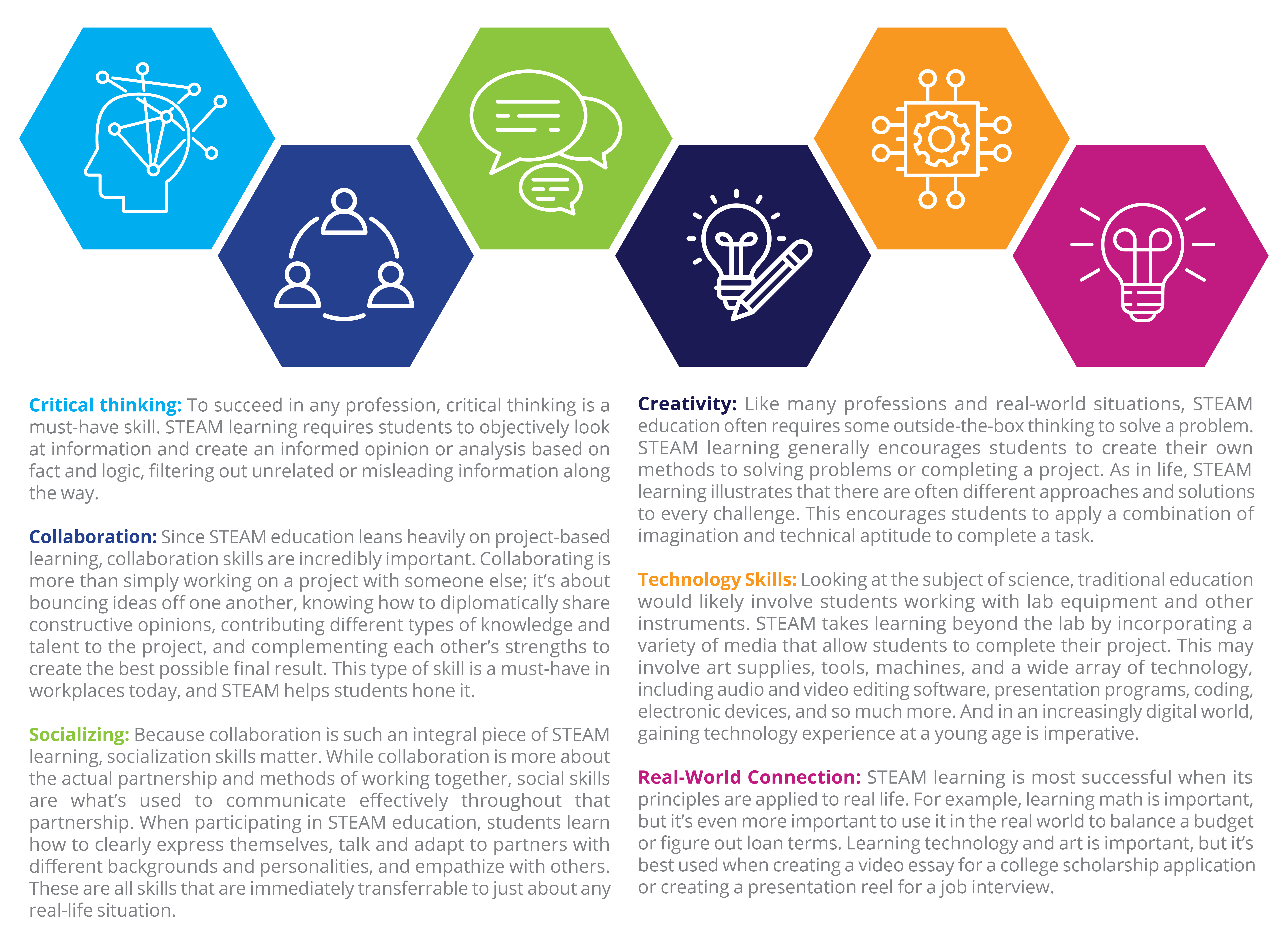What is STEAM education? Why is it important in schools today? What are the benefits? There’s plenty to know about STEAM learning, a form of education that’s exploded in popularity in recent years. And we’ll cover it all in this article.
Table of Contents
What is STEAM education?
STEAM education is a learning approach that employs Science, Technology, Engineering, Arts, and Mathematics to provide students with a well-rounded education that touches on all of these subjects. STEAM focuses heavily on practical, real-life skills, such as emotional, social, and communication, which are vital tools for students to have once they’re ready to enter the workforce. STEAM education also emphasizes the importance of collaboration and creativity, which makes it ideal for team projects and group problem solving.
As its acronym suggests, STEAM also works art into the equation (unlike STEM, which we’ll cover shortly). The arts aspect allows students to demonstrate their creativity when learning about and presenting their findings.
Why is STEAM education necessary today?
In today’s world, an education must provide more than just subjects and lessons. Students need to understand how to think critically, observe, communicate effectively, find patterns, solve problems, analyze information, predict outcomes, and work collaboratively. These are all skills necessary to succeed in life outside of school, and STEAM projects and activities are designed to bring these skills to the surface.
Plus, STEAM education fosters engagement and excitement about learning, which is critically important given that learning loss and chronic absenteeism are so prevalent in schools today. Implementing a type of learning that students enjoy and eagerly anticipate can go a long way toward reversing those negative trends.
What are the top benefits of STEAM education for students?
As a whole, STEAM learning contributes to a well-rounded education in which students learn important life skills as well as traditional subjects such as ELA, math, science, and more. Here are some of the top benefits of STEAM education:

What are practical examples of STEAM activities?

How can STEAM education be implemented to children in school?
There are a variety of ways to implement STEAM activities and learning into schools. Here are a few guidelines and recommendations:
- Make sure you’re incorporating as many of the core STEAM subjects as possible into any project or activity.
- Don’t make them too complicated for students; everyone should be able to contribute and participate regardless of experience or knowledge of the subject matter.
- Provide students with the materials you have at your disposal, whether that’s as simple as a piece of paper and a pencil or as technological as coding programs to build robots. Anything and everything can be considered for a STEAM project.
- Connect each project or activity to a real-world situation or lesson so students get the most out of STEAM learning.
STEM vs. STEAM
One of the most common questions surrounding STEAM education is, “What’s the difference between STEM and STEAM?” The short answer is that STEAM and STEM are the same, except that STEAM incorporates art components into learning where STEM does not. A more detailed explanation is that, while STEM learning excels in practicing concepts related to science, technology, engineering, and math and helps prepare students who may pursue further education or a career in those fields, it’s missing a large piece of the puzzle.
Creation, innovation, presentation—these aspects are generally overlooked with STEM learning, but they are quite prevalent in STEAM education. STEAM essentially takes the best parts of STEM and uses those principles through an arts lens. STEAM lets students connect their STEM learning through design practices and innovation in the arts. But the “arts” in STEAM isn’t just tacked on to the rest—it changes the complexion of each lesson to create something entirely new and different.
How Catapult Learning can help
Catapult Learning’s STEAM program, which can be implemented during the school year and over the summer, is a hands-on, project-based, exploratory learning experience for your students, designed to develop critical thinking and problem-solving skills and draw connections to real-world applications.
Our STEAM enrichment includes:
- Supplemental curriculum and implementation tailored to your district’s needs
- Interactive, hands-on lesson materials chosen by our academic experts
- Collaborative training support and professional development for school leaders and staff
If your school hasn’t yet invested in STEAM learning, now is the time. Catapult Learning can help you get started. Visit https://catapultlearning.com/programs/instruction/stem/ for more information.
